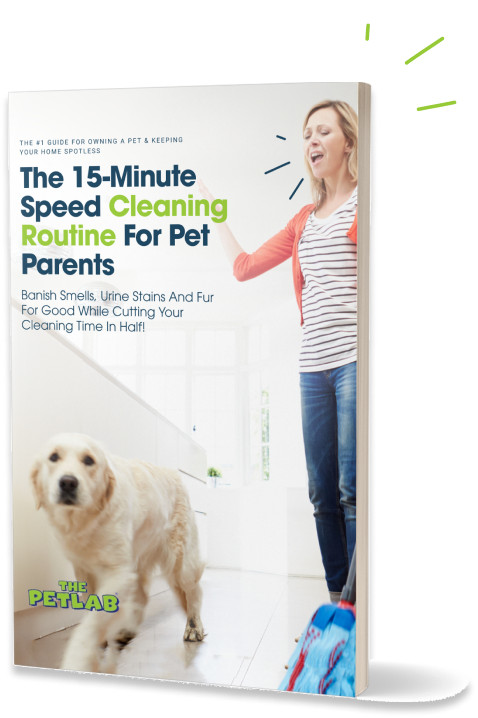Raise your hand if your dog's coat makes you proud! Glossy, smooth, and clean—you love how it looks, feels, and getting approving comments from other fur parents rocks. 😉
But when those hairs fall out, you question what you're doing wrong... and how they got everywhere?!
ALL the reasons dogs shed
Fur real: Closed doors can’t keep those hairs from going places. Like clinging to your wife’s cherished throw blanket. Clogging up heavy-duty vacuum cleaners. Or garnishing soups and salads. Talk about fur without borders! Seriously, why do dogs shed? We have answers.
#1: Genetics
Some breeds, like Labrador Retrievers, German Shepherds, and Newfoundlands, shed more than others. Why? Genetics. 🧬
To be more precise, four genes determine what kind of coat your pup will have and whether he will be a light, moderate, or heavy shedder:
- RSPO2 (R-spondin-2): Found in wire-haired dogs (think Poodles)
- FGF5 (fibroblast growth factor 5): Short or long hair coat
- KRT71 (keratin-71): Associated with curly hair (hi, Airedale Terriers etc.)
- MC5R (melanocortin 5 receptor): Degree of shedding
RSPO2 and MC5R have the most influence on shedding levels.
#2: Temperature control
Many dog breeds rid themselves of unneeded hair for a lighter coat in the summer, then shed again around autumn to allow thicker fur to grow for the winter. But sudden temperature changes—anytime in the year—can also set the hair renewal process into motion. Such dog shedding helps your pet regulate body temperature and is completely normal.
#3: Artificial light
Here's one factor you might not have known. Exposure to artificial light disrupts what's known as photoperiod (hours of sunlight in a day and its corresponding effects on animals), resulting in near-constant, year-round shedding in indoor dogs. Good gracious!
#4: Nutritional deficiency
Dogs need a balanced and complete diet for optimum well-being. Nutritional deficiencies or malnutrition can lead to severe shedding and hair loss. The solution? High-quality, age- and breed-appropriate dog food. Your vet may even recommend supplements.
#5: Dehydration
It's not the first thing that comes to mind, but dehydration is a common cause of dry and itchy skin in dogs. This contributes to excessive shedding as dogs scratch themselves, and hairs become brittle and more prone to falling out. Moral of the story: Make sure your pet gets enough water.
#6: Fur-getting to brush
Lack of hair brushing and the wrong tools can leave your fur baby with matted hair or damaged skin. Plus, a propensity for shedding like crazy. 😑 Fortunately, there's an easy fix: Regular grooming.
Pet parents typically need multiple tools like a slicker/rake brush and the Grubby Paw Grooming Mitt for best results. Our mitt massages the skin, distributes natural oils, supports blood circulation, and soothes dogs—all while removing unwanted fur!
#7: Pregnancy
Two things worth noting here:
- Pregnant/nursing dogs may lack vital nutrients for a healthy coat. This can lead to exaggerated (and out-of-season) shedding.
- After giving birth, post-partum stress and hormone changes contribute to shedding.
#8: Allergies
A wide range of allergens can trigger shedding and cause unwanted hair loss. For example:
- Food sensitivities to lactose, proteins, soy, and wheat.
- Strong pet soaps and shampoos.
- Pollen, mold, and dust mites in the home.
- Irritants in everyday household cleaning solutions, laundry detergent, and fabric softeners.
Eliminating allergens helps control shedding—but it can be a fur-midable challenge!
#9: Skin trauma
Injuries to the skin from obsessive licking, sunburns, chemically-treated carpets and lawns, and contact with caustic products all up the risk for massive shedding—big time!
Keep a hygienic home with PetLab's trusted selection of pet-safe cleaning products that prevent skin trauma and doggy allergies.
#10: Illness
Now to the scary (and definitely-not-normal) causes of dog shedding.
Fungi like ringworm and parasites like fleas, ticks, and lice cause discomfort and inflammation of the skin. Fido will lick, scratch, and bite affected areas for relief—until his hairs fall out.
Some medical conditions (immune disorders, endocrine problems, adrenal/inflammatory bowel/kidney disease, liver failure, cancer) can also increase shedding and hair loss.
#11: Medicines
Long-term use/high doses of certain canine medications (e.g. chemotherapy drugs and corticosteroids) have a side effect of shedding or hair loss.
#12: Worries
Stress and its sister condition, anxiety, can cause extreme dog shedding. Something as normal as seeing you slip into office attire can trigger separation anxiety in your pup! Help your pet out by familiarising yourself with doggy stress signs.
Shed happens, but when is it a problem?
Shedding is a healthy and natural function most of the time, but too much may need medical attention.
✔️ If shedding happens uniformly all over the body, you probably have nothing to worry about.
❌ If you notice more hair loss than usual, random bald patches, or other clues suggesting this isn't seasonal/genetics, consult your vet.
Now, please excuse me. Gotta brush my dog. 😆 Until next time!
Disclaimer: This post is for informational purposes only. It is not and does not intend to be a substitute for professional veterinarian advice, diagnosis, or treatment. Reliance on any information on this website is at your own risk. Always consult with your veterinarian.


